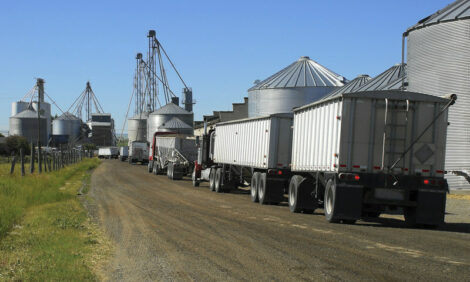



MU animal scientists assist national effort to preserve swine genetics
COLUMBIA, Mo. - Although Tim Safranski visits many hog producers each year, his trip to the Bohannon family farm near Gallatin, Mo., last fall was not a typical house call for the University of Missouri state swine breeding specialist.
|
Safranski spent two days on the Daviess County farm collecting semen samples from the Bohannons' two Hereford boars. Samples from the rare swine will be included in the National Animal Germplasm Program (NAGP), a U.S. Department of Agriculture initiative started in 1999 to preserve the genetic variation in the nation's livestock species for the future.
"During the past two decades, U.S. livestock production has become much more standardized," said Safranski, who is a member of NAGP's swine species committee. "Producers have increased the use of genetic improvement technologies such as artificial insemination. While this has allowed for the production of uniform, high-quality consumer products, it also has reduced the total number of breeding stock in use. As a result, genetic diversity is being lost. And once it's gone, it's gone."
Safranski said maintaining diversity is crucial because it allows livestock producers to respond to changes in production environments, consumer demands and diseases. He cited the southern corn leaf blight outbreak of 1970 - the greatest economic loss in a single crop in a single year in the entire history of agriculture - as proof of the importance of maintaining genetic diversity.
In that year, the southern corn leaf blight spread rapidly across the United States because of the lack of genetic diversity in the U.S. corn varieties. About 80 percent of corn planted in 1970 was of a hybrid that had shown high resistance to the disease. However, a new variant of the blight had evolved to which the corn was susceptible. The outbreak destroyed 15 percent of the crop, and total losses were estimated at $1 billion.
"If earlier hybrids with genetic resistance to the disease had not been stored, who knows what would have happened to U.S. corn production," Safranski said.
'Noah's Ark on Ice'
In order to remain viable, animal germplasm contained in semen and embryos must be frozen, or cryopreserved, in liquid nitrogen at -18 degrees Celsius. The NAGP collection is stored in such a facility at the National Center for Genetic Resources Preservation in Fort Collins, Colo. The collection currently includes more than 30,000 samples from beef and dairy cattle, poultry, sheep, goats and swine, including the semen Safranski collected from the Bohannons' boars.Because the program's goal is to capture as much genetic diversity as possible, deciding which individuals from each breed and population to include is important. Bill Lamberson, MU professor of animal sciences, developed a genetic algorithm to help make that determination in swine.
"The algorithm's purpose is to identify a group for collection with the least level of relatedness among individuals within a population," said Lamberson, who developed the formula with his son, P.J., a mathematics graduate student at Columbia University, while driving to Wyoming for a fishing trip. "Those individuals who are the least related are expected to provide the greatest number of unique genes, or alleles, and they best represent the population's genetic diversity."
Lamberson's algorithm also is being used to identify candidates for inclusion in cattle and other species.
Safranski said 2002 was the first year NAGP collected swine samples. The swine committee selected Yorkshires, the largest U.S. swine breed, and Herefords as the first major and minor breeds to be collected. Safranski volunteered to coordinate the Hereford collection.
"Our goal is to collect samples from at least 90 boars," he said. "Though there are some logistical hurdles to overcome, such as timing semen collections to when the herd's sows are in heat, we're hopeful we'll meet our goal. Right now we're trying to secure funding to hire an intern who would travel this summer to collect in Ohio and Indiana."
Although the next minor breed hasn't been selected, collection from Berkshires, the next major breed, is under way. Safranski and Lamberson said the next minor breed could be the Tamworths, the Mulefoots or the Wessex Saddlebacks.
"Missouri has more than its share of minor breeds," Safranski said. "It could be a major seed stock source for this program."
Safranski said anyone with Hereford boars they believe might be candidates for collection should contact him at (573) 884-7994 or .SafranskiT@missouri He said those interested in learning more about the swine program could contact Terry Stewart, professor of animal breeding and genetics at Purdue University, at [email protected]
More information about NAGP also is available online at www.ars-grin.gov/nag/.
Source: AgEBB, Swine Production News, 17th February 2003














